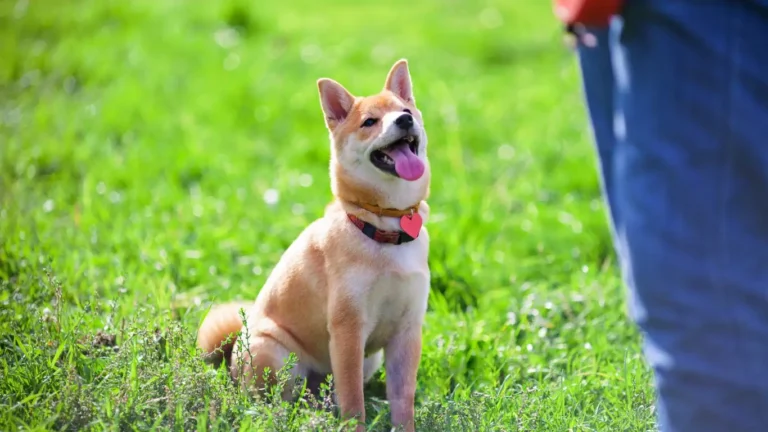5 Proven Ways to Train Your Dog to Stop Barking at Strangers
As a veterinary technician specializing in nutrition, I’ve had my fair share of challenges working with dogs and their behavior, especially when it comes to something as common as barking at strangers. One of the questions I get asked a lot is, “How to train a dog to stop barking at strangers?” It’s a concern that many dog owners face, and I get it – it can be frustrating when your dog’s constant barking makes outings stressful or even embarrasses you when visitors come over. But don’t worry, you’re not alone, and with patience and the right techniques, you can train your dog to stop barking at strangers in no time!
The Root Causes of Barking at Strangers

Before diving into how to train your dog to stop barking at strangers, it’s important to understand why dogs do it in the first place. Dogs are social animals, but their understanding of the world around them is different from ours. When they see someone they don’t recognize, their instinct is often to bark. It’s their way of saying, “Hey, who are you, and what are you doing here?” This can be especially true for dogs that are naturally protective or more wary of unfamiliar faces. Other reasons could include fear, anxiety, or territorial behavior, so figuring out the cause is the first step in solving the issue.
Fear and Anxiety
One of the most common reasons why dogs bark at strangers is because they’re scared. If a dog has had negative experiences with unfamiliar people or hasn’t been properly socialized, they might feel threatened or anxious. When they bark, it could be their way of trying to ward off what they perceive as a threat. This is where the challenge lies – it’s not always about the stranger themselves, but how your dog feels about the situation.
Territorial Instincts
Another reason for barking at strangers is territorial behavior. Dogs are natural protectors of their home, and if they see someone they don’t know entering their space, their instinct is to warn them away. This type of barking is more common in dogs that are very loyal or have a strong attachment to their owners and their environment. While territorial barking isn’t inherently bad, it can be annoying and excessive if not addressed properly.
Steps to Training Your Dog to Stop Barking at Strangers

Now that we understand why dogs bark at strangers, let’s talk about how to address the behavior. There are several methods that I’ve found to be effective over the years, and I’ve seen great results with my own pets as well as with many clients. Each dog is different, but a combination of these steps can help curb the unwanted barking.
1. Start with Socialization
One of the first things I always recommend is socialization. It’s crucial for dogs to become accustomed to meeting new people in a calm, controlled way. The earlier you start, the better, but it’s never too late to work on socializing an adult dog. The goal is to help your dog understand that not all strangers are threats and that people entering your home or walking past aren’t something to be alarmed about.
Take your dog to various environments – parks, pet stores, and other public places – where they can observe people from a safe distance. Gradually decrease the distance between your dog and the strangers as they become more comfortable. Keep the experience positive by rewarding calm behavior with treats and praise.
2. Use Positive Reinforcement
Positive reinforcement is one of the most effective techniques in dog training, and it’s something I swear by. When your dog remains calm and doesn’t bark at a stranger, immediately reward them with a treat, affection, or praise. This helps reinforce the idea that good behavior leads to positive outcomes. Consistency is key here – every time they remain calm, they should get a reward. Over time, your dog will start associating calm behavior with rewards and will begin to relax more around strangers.
3. Teach “Quiet” Command
Another powerful tool I use with clients is teaching the “quiet” command. This is a simple but effective way to control barking. Start by letting your dog bark a few times when they see a stranger (as long as it’s in a safe, controlled environment). When they start barking, say “quiet” in a calm but firm voice. Wait for a moment of silence – even just a second – then reward your dog with a treat or praise. Repeat this process until they begin to associate the word “quiet” with stopping barking. With practice, your dog will start to understand that they need to stop barking when they hear that word.
Consistency and Patience Are Key

It’s important to remember that training takes time, and every dog is different. Some dogs may catch on quickly, while others might need more time. The key is to stay consistent with your training and be patient. If you find that your dog’s barking is particularly difficult to manage, don’t hesitate to consult with a professional dog trainer. They can offer guidance and help fine-tune your approach.
4. Manage the Environment
In addition to training, managing your dog’s environment can also help reduce barking at strangers. If your dog is more likely to bark when they see someone walking by the window, try blocking their view by using curtains or a dog gate. If they bark when someone comes to the door, consider training them to go to a designated spot when the doorbell rings. These small adjustments can make a big difference in reducing the frequency of barking.
Ultimately, the goal is to create a calm, controlled environment where your dog feels safe and secure around strangers. By combining proper socialization, positive reinforcement, and patience, you can significantly reduce your dog’s tendency to bark at unfamiliar faces.
Addressing Fear-Based Barking

In Part 1, we discussed some of the root causes of barking at strangers, including territorial instincts and anxiety. Now, let’s dive deeper into how to manage and address fear-based barking, which is often one of the trickier behaviors to correct. As I’ve seen firsthand, dogs who bark at strangers out of fear often need a little more time and understanding to overcome this response.
Creating Positive Associations with Strangers
When a dog barks at strangers out of fear, it’s essential to change how they perceive new people. This is where the process of desensitization comes in. The goal is to help your dog feel safe and relaxed around strangers, so they don’t feel the need to bark. The trick is to introduce them to unfamiliar people slowly and with positive reinforcement.
Start by having a friend or family member come over to your home, but ask them to keep their distance at first. Let your dog observe them from afar, and make sure the environment is calm and relaxed. If your dog doesn’t bark, reward them immediately with a treat or praise. If they do start barking, don’t punish them. Instead, calmly redirect their attention and wait for a moment of silence before rewarding them. Over time, the stranger can move a little closer, and you can repeat the process.
Building Trust Through Repetition
Consistency is key when working with fearful dogs. The more often you expose them to strangers in a controlled, positive way, the more they will begin to associate new people with good experiences. Gradually, the barking should decrease as they start trusting that nothing bad will happen when someone new is around.
Using Commands to Interrupt Barking

Now that we’ve tackled fear-based barking, let’s talk about using training commands to interrupt barking when it happens. This technique is particularly helpful when your dog starts barking before you have a chance to intervene. Over the years, I’ve found that teaching a “watch me” or “look” command can be a game-changer in redirecting your dog’s focus away from the stranger and back to you.
Teaching “Watch Me” Command
The “watch me” command is exactly what it sounds like – it teaches your dog to focus their attention on you instead of whatever is causing the distraction. To teach this, start by holding a treat near your face and saying “watch me” in a calm voice. When your dog looks at you, immediately reward them. Once they start catching on, practice in various environments with different distractions. Over time, your dog will learn to focus on you when given the “watch me” command, even in the presence of a stranger.
How to Apply “Watch Me” During Barking
Once your dog reliably responds to the “watch me” command, you can begin using it when they start barking at a stranger. The moment they start barking, say “watch me” and reward them when they turn their attention toward you. This helps break the barking cycle and shifts their focus to something positive. Eventually, this becomes an automatic response for your dog whenever they feel the urge to bark at unfamiliar faces.
Preventing Barking at the Door

Another common situation where dogs bark at strangers is when someone rings the doorbell or knocks. It’s a classic scenario that can be particularly disruptive if not addressed. The good news is that with some practice, you can teach your dog to remain calm when someone comes to the door. Here’s how I’ve helped many pet parents manage doorbell barking.
Setting Boundaries at the Door
The first step in preventing doorbell barking is to set boundaries. When someone rings the doorbell, it can trigger an immediate reaction from your dog. To break this habit, you can teach your dog to go to a designated spot, like a mat or crate, when they hear the doorbell. This is where the “place” command comes in handy. When you know the doorbell is about to ring, cue your dog to go to their spot. Reward them when they do it calmly. Over time, your dog will start to associate the doorbell with going to their designated place, rather than barking at the door.
Reinforcing Calm Behavior
While setting boundaries is important, reinforcing calm behavior is equally crucial. When someone knocks or rings the doorbell, you can prevent barking by rewarding your dog for staying quiet. I’ve found that a high-value treat (something your dog really loves) works wonders here. The key is to reward calm behavior consistently. If your dog remains quiet and sits on their mat, immediately reward them with a treat. This positive reinforcement helps your dog understand that quiet behavior at the door leads to good things.
Managing Hyperactive Barking Around Strangers
Not all dogs bark out of fear or anxiety; some are simply excitable and overly enthusiastic about meeting new people. If your dog is the type who barks in excitement when a stranger arrives, the key is to manage that excitement before it turns into excessive barking.
Calm Greetings and Interaction
The best way to deal with an overly excited dog is to train them to greet people in a calm, controlled manner. One method that works well is to have your dog sit before they interact with a stranger. This helps them understand that they need to be calm before receiving attention. Start by asking your dog to sit when they greet a person. If they start barking, ask them to sit again and ignore them until they calm down. When they sit quietly, reward them with attention or a treat. Over time, your dog will learn to stay calm when they meet new people.
Redirecting Energy
If your dog is very energetic and tends to bark out of sheer excitement, another strategy is to redirect that energy. Before someone arrives, give your dog a task to do, like a puzzle toy or a game of fetch. This helps tire them out and calms their excitement. When they are mentally and physically tired, they’ll be less likely to bark uncontrollably when the doorbell rings.
By incorporating these strategies, you can help your dog learn how to greet strangers calmly and avoid barking excessively. With time, patience, and consistency, you’ll be able to create a more peaceful environment for both your dog and guests.
When to Seek Professional Help

While many dog owners can successfully train their dogs to stop barking at strangers with time, patience, and the right techniques, there are times when seeking professional help is the best course of action. As someone who’s worked with a wide variety of dogs and their owners, I’ve seen first-hand how some dogs require a more personalized approach, especially when the barking is persistent or has deeper underlying causes.
Behavioral Issues That May Require Professional Help
There are several signs that might indicate it’s time to consult with a professional trainer or behaviorist. If your dog’s barking is particularly intense or frequent, or if they show signs of aggression toward strangers, it might be necessary to have an expert assess the situation. Dogs that are fearful or aggressive may require specialized training techniques that a professional can provide.
If your dog has a history of trauma, negative experiences, or extreme anxiety, a behaviorist can help address these underlying issues in a way that’s safe and effective. For example, dogs who have been abused or abandoned may develop deep-seated fears that take longer to overcome. In these cases, a professional can work with you and your dog to slowly desensitize them to strangers and help them develop healthier coping mechanisms.
Choosing the Right Professional
When choosing a professional to help with your dog’s barking, it’s important to select someone with experience in behavioral issues and positive reinforcement techniques. Always look for trainers or behaviorists who are certified by recognized organizations, such as the Association of Professional Dog Trainers or those who have a strong background in science-based training methods. You want someone who understands the psychology of dog behavior and can guide you toward long-term solutions.
Dealing with Setbacks and Progress

Training a dog to stop barking at strangers is a journey, and like any journey, there will be setbacks. It’s important to understand that behavior modification doesn’t happen overnight. There will be times when your dog barks at a stranger despite all your hard work. But that’s okay! Don’t get discouraged – it’s all part of the process. It’s crucial to stay consistent with your training and remain patient with your dog.
Understanding the Learning Curve
Every dog learns at their own pace, and this is something I remind clients regularly. Some dogs might catch on quickly, while others may take longer to show improvement. If your dog has made progress but then starts barking again, it’s important to reassess the situation calmly. Was there a new trigger that caused the behavior to resurface? Did your dog get less training or reinforcement recently? These are questions that can help you identify any potential gaps in the training.
How to Adjust Your Approach
If setbacks are happening, don’t be afraid to adjust your approach. Perhaps your dog needs more socialization with strangers, or maybe the rewards you’re using aren’t motivating enough. Sometimes, a simple change in the environment or the training routine can make a huge difference. The key is to stay flexible and open to modifying the plan as needed. Your dog may not be perfect, but with continued effort, you’ll see progress.
Why Consistency and Patience Matter
As I’ve said before, consistency and patience are two of the most critical elements in training your dog to stop barking at strangers. Your dog doesn’t just need to learn what to do – they need to learn that you are reliable and that the rules are always the same. When training, it’s essential to stick with the plan and avoid confusing your dog by allowing exceptions. Every time you reinforce calm behavior, you’re building a stronger foundation for future success.
Reinforcing Good Behavior in Everyday Situations
One of the best ways to maintain progress is by incorporating the training into everyday life. You don’t need to wait for strangers to come by to practice your dog’s calm behavior. Use daily walks, car rides, or trips to the park as opportunities to reinforce your dog’s ability to remain calm around unfamiliar people. This way, your dog will start generalizing their calm behavior to all situations, not just when you’re actively training them.
Also, don’t forget that your attitude matters. Dogs are incredibly in tune with their owners’ emotions. If you’re feeling frustrated or stressed, your dog might pick up on that and become anxious themselves. Keeping a positive and calm demeanor will not only help you feel more relaxed but will also make it easier for your dog to follow your lead.
References
- Association of Professional Dog Trainers
- American Kennel Club
- PetMD
- National Institutes of Health
- Health.com
Disclaimer
The information provided in this article is based on my personal experience and professional knowledge as a veterinary technician specializing in nutrition and dog behavior. While I aim to provide helpful and accurate advice, please note that every dog is different, and training results may vary. Always consult a professional dog trainer or veterinarian if you have specific concerns about your dog’s behavior. This article is intended for informational purposes only and should not replace professional advice or treatment.






